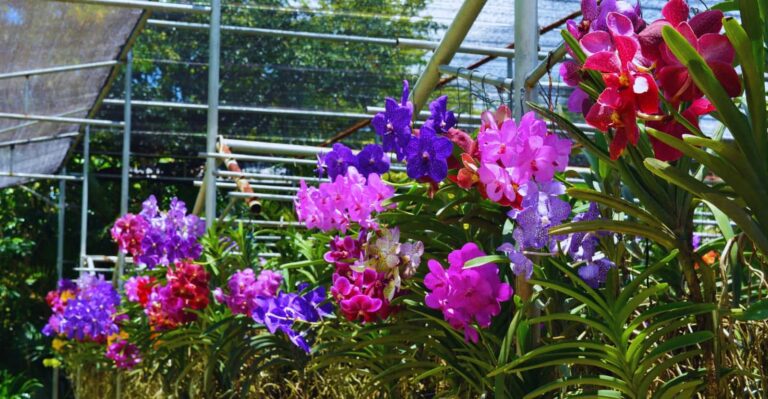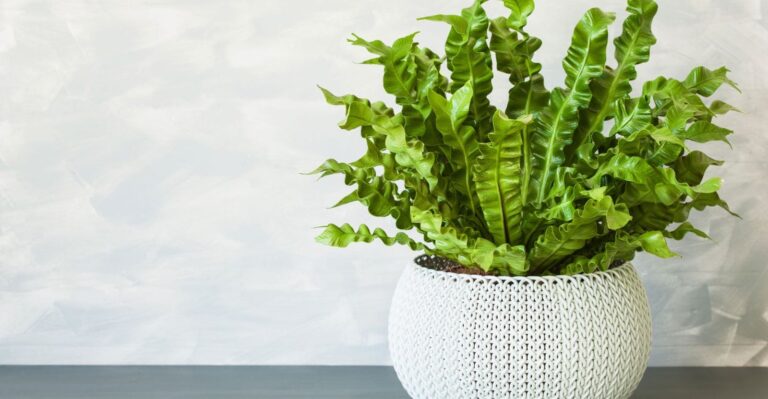Amazon has put together some great Home Gift Deals – save money and get your shopping done at the comfort of your home! Click here to see deals on Amazon
The Philodendron white knight is a beautiful and rare type of tropical plant that’s popular for its ability to fill homes with natural greenery. It’s an easy plant to care for as well! Knowing how to properly care for your plant’s needs is crucial for its healthy growth.
If you’re considering bringing this beautiful plant to your home, follow this extensive Philodendron white knight guide to discover how to care your new plant successfully. Once you understand the fundamental requirements, it will thrive very well.
Some products at Amazon to grow and care for White Knight Philodendron:
- Captain Jacks Dead Bug Brew Concentrate
- Espoma Organic Potting Soil Mix
- Osmocote Smart-Release Plant Food
- Organic Perlite by Perfect Plants
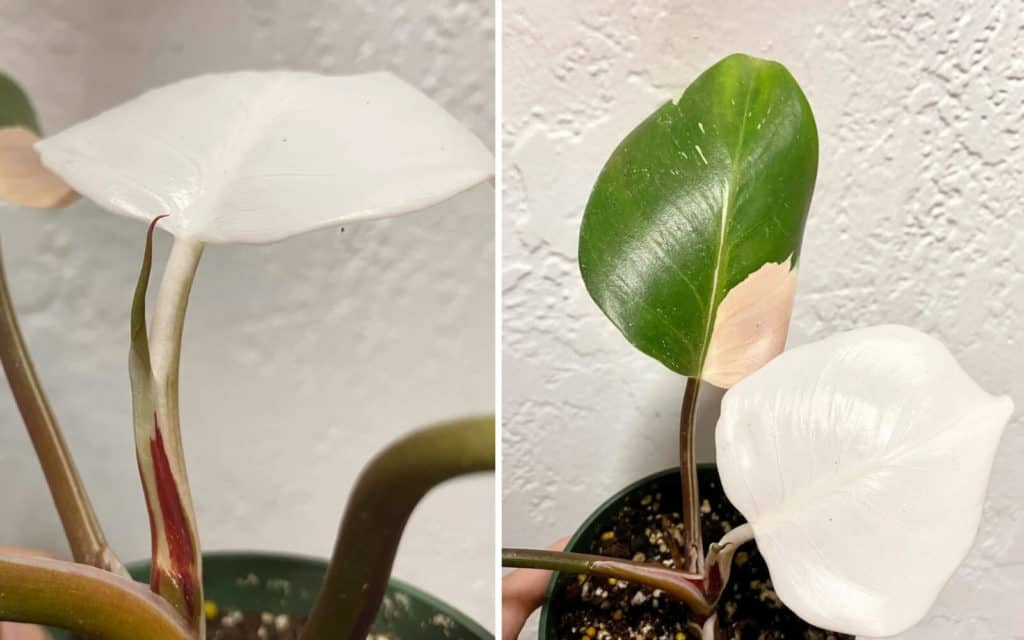
What is Philodendron White Knight?
Philodendron white knight is a beautiful houseplant that originates from tropical rainforests. It’s easy to grow, requires little maintenance, and makes a great low-maintenance indoor plant. It has large, heart-shaped leaves and striking white flowers that appear in summer.
The variegated white foliage is one of the reasons that the plant looks so pleasing. Beautiful flowers appear during spring and summer, clinging to the spadix. You can see an orchid blossom on the spadix protected by an extended spathe.
Origin: The white variegation Philodendron White Knight is a rare tropical plant native to South American rainforests. A member of the Araceae family, the Philodendron genus is named for the Greek term “Philo,” which means love or affection, and “Dendron,” which means tree.
The availability of white variegation plants is limited and among the most sought-after plants by plant enthusiasts. Those living in Europe and the United States hold this genus in high esteem.
Appearance: The Philodendron White Knight plant may grow up to three meters, and its leaves can grow to a maximum length of 1.5 ft. Philodendron leaves look somewhat heart-shaped, and due to their epiphyte nature, it climbs up trees.
Other names: Philodendron sp. “White Knight.”
| Factor | Growth Condition |
|---|---|
| Soil | Moist well-drained soil |
| Water | Once to twice a week |
| Sunlight | Indirect 4-6 hours of sunlight |
| Temperature | 65°F–80°F (18°C–26°C) |
| Fertilizer | Slow release liquid fertilizer |
| USDA Zone | 9 to 11 |
| Common Problem | Yellow Leaves, Brown leaf tips |
| Where to Buy | Etsy |
How does Philodendron white knight differ from other plants?
The White knight philodendron for indoor gardens has a leaf pattern unlike any other plant. Beginner gardeners often have trouble distinguishing it from other plants.
The most distinguishing feature of white knights is their variegation. The lower chlorophyll levels in Philodendron cells cause the variegation in leaves, as chlorophyll is what makes a plant green.
Three types of variegation can happen in the plant—Genetic variegation, Chimeric variegation, and Viral variegation. Genetic variegation happens due to cellular level mutation in the parent plant. You will have a higher chance of retaining variegation in new plant propagation and remaining stable.
The Chimeric variegation isn’t very stable and happens due to a random mutation. When you propagate from variegated leaves and twigs, you won’t have a variegated plant.
Viral variegation happens due to an harmless virus that creates discolored leaf spots. This kind of variegation is stable, so you can propagate a rhizome with variegation by infecting the plants, and the new plant will also have the variegation.
Philodendron white knight vs. white wizard
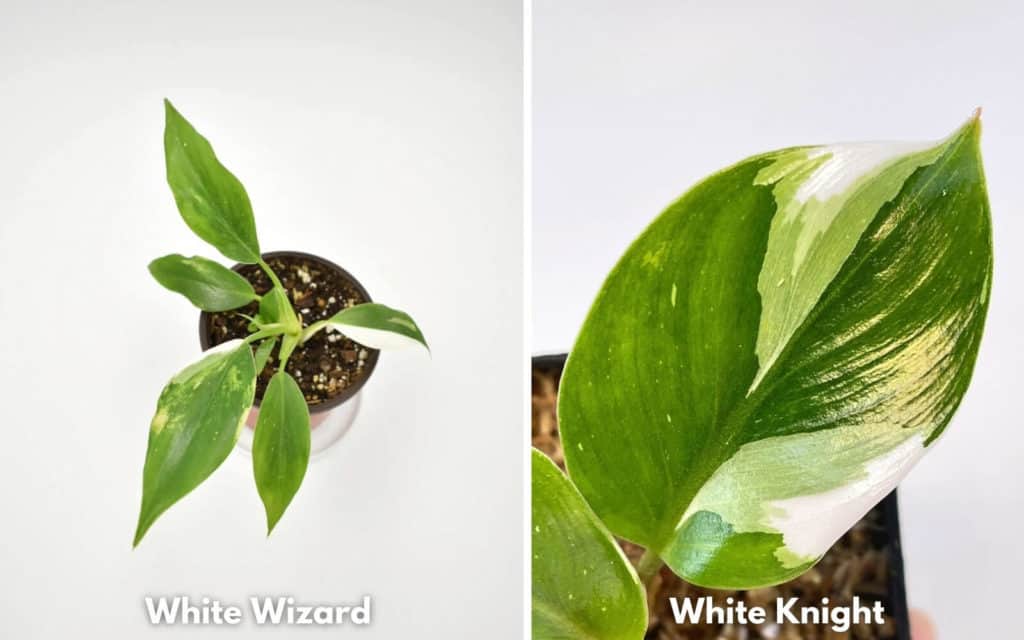
Both plants have large dark green leaves with white veins and spots. However, you need to know some essential differences between a white knight and a white wizard.
The stem and leaves of the variegated philodendron are almost identical, but their stem sizes and textures are different. The Philodendron white knight has vine stems tinged with purplish-white leaves.
There are white foils on some White Knights, but they will always exhibit a burgundy or purple color, thereby reducing their greenness.
Another distinct finding is that the White wizard philodendron has a glossier but larger leaf. Although their looks differ, these plants have similar care and maintenance needs.
Nevertheless, the White knight has rounder beautiful plant leaves than the white wizard philodendron, making it a great indoor plant. It’s a climber, meaning it will climb and grow upward if you provide a trellis.
Philodendron white princess vs. white knight

They vary in appearance concerning their stems and leaves. The White Princess plant has dark purple or reddish-brown leaf stalks, whereas the White knight has dark purple or reddish-brown stem with a white leaf.
The White Princess hybrid has white variegation and sometimes accrues light pink shades. The White Princess plant also has smaller, narrower rounded leaves than the White Knight plant. The White Knight is a self-heading plant, while the White Princess is a climber.
How to care for Philodendron White Knight
Caring for Philodendron White Knight is easy, but there are some things you need to know beforehand.
Soil
Philodendron White Knight thrives in damp, moist soil with high organic content material, such as peat moss or compost potting soil. It also does well in rich soil. Therefore, soil with a high organic matter content is the best as it allows it to grow faster.
You can add perlite and orchid bark to improve the soil drainage. It makes the soil looser to accommodate more air and moisture to flow through. By increasing the water amount in the soil, the plant’s oxygen intake from the ground may decrease, hamper growth.
Light
Plants get their nourishment from sunlight. White knight, for instance, grows best with modest light. Filtered indirect light is most appropriate as direct exposure to sunlight will damage the plant.
A few months of low indirect sunlight exposure may change the color of the variegated leaves. However, the white portion of the leaf is more susceptible to direct sunlight. When exposed to intense sunlight, it burns off quickly.
Given that your eastern window receives less indirect sunlight than your southwest-facing window, a north-facing one is best if you live in a cooler area.
Water
White Knight philodendrons like soil to be consistently moist, benefiting from regular watering. This is especially true during the warmer summer months.
Thus, you want to ensure the soil gets sufficiently soaked with water in summer. But, avoid overwatering with too much water or allow the plant to sit in water for long periods, increasing the chance of root rot.
Soil saturated with water has no room for the oxygen needed in the plant’s roots. This shortage of air starves the plant of its ability to grow. Your roots won’t absorb water properly if your soil is oversaturated.
When roots lose the ability to absorb water or nutrients from the soil or fertilizer, the plant will wilt and wither. The best way to prevent this is to test the soil before watering.
Slipping your finger into the soil not more than 1 to 2 inches deep will allow you to test soil moisture before watering.
Temperature
As a tropical plant, Philodendron White Knight consistently thrives in the warm temperature. Its preferences are more nuanced, though. For instance, most prefer temperatures between 65°F–80°F (18°C–26°C), but some can tolerate a slight temperature variance of 5 to 10 degrees.
But you need to make sure that outdoor temperatures never dip below 55°F (12°C) because such low temperatures don’t suit Philodendrons.
It thrives in USDA zones 9 to 11 in the United States. Here, you can keep your plant out all season. If you live somewhere below USDA zones 9, keep it indoors during the cool months of the year.
If you wish, you can take it outside during the warmer months. Frost and extreme temperatures aren’t at all tolerated by this plant. In any case, anything cooler or warmer than that temperature range will make the plant struggle.
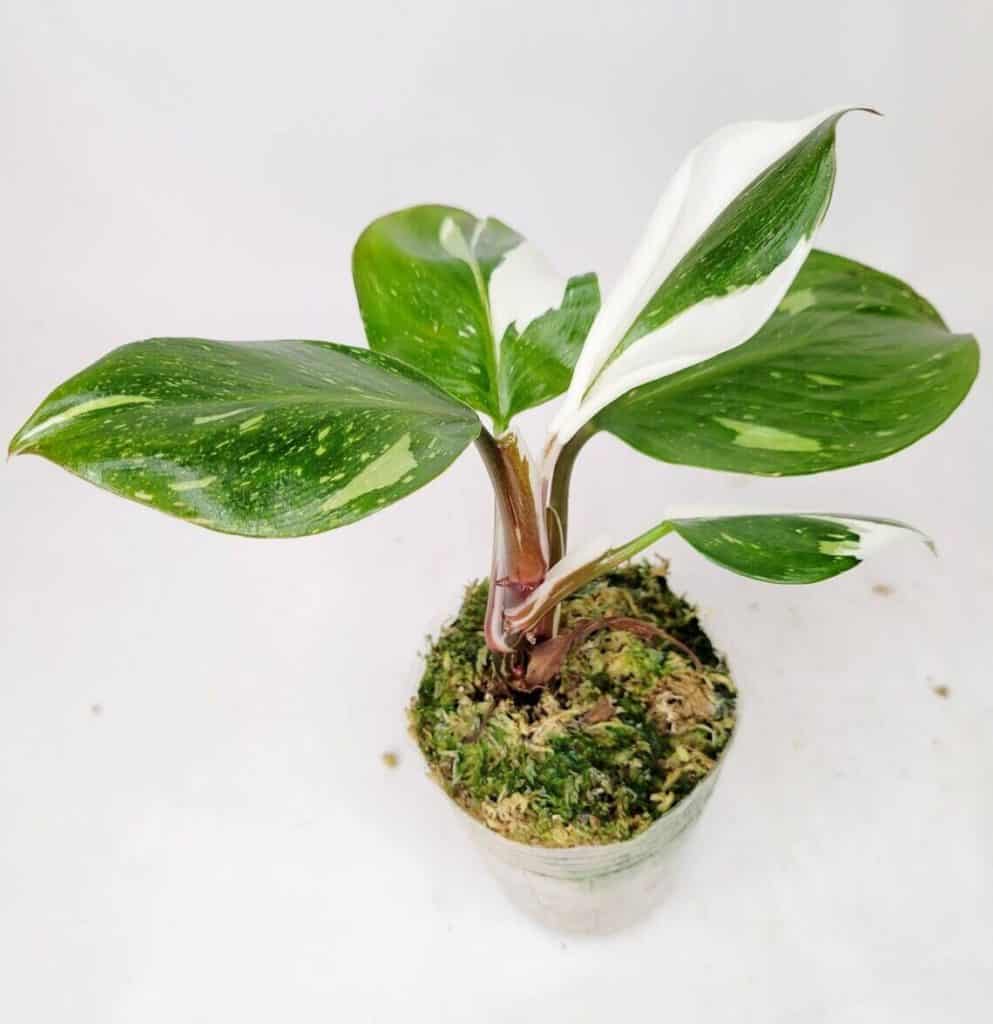
Humidity Requirement
Philodendron White Knight is a tropical plant, so it’s not surprising that it’s particularly fond of a wet environment. The ideal range for your plant’s humidity level should be anywhere in the range of 70 and 80 percent.
If it’s within this range, its health will improve. But, if your home’s humidity isn’t optimal, you can use natural treatments, like grouping plants and placing rocks or stones in saucer pans to help raise the humid environment around the plant.
Fertilizer
Fertilizer is vital for White knights, helping them grow and develop. It also helps maintain soil fertility, which is especially essential if growing a White Knight indoors as a houseplant. Slow-release granular fertilizer is also highly beneficial for this purpose.
Some beneficial liquid fertilizer ingredients are phosphorus, calcium, potassium, magnesium, zinc, iron, and nitrogen. These factors all contribute to a plant’s health and well-being, improving everything from its root system to its foliage.
Minerals such as potassium assist in fostering a strong root system, and nitrogen improves plant appearance.
Like water, excess plant food can harm the white knight. That’s because fertilizer residue tends to build up in the soil. Thus, the more you feed your plants, this accumulation will occur.
Additionally, excessive levels of fertilizer can burn the roots of your plants. Some growers like to use slow-release fertilizer because it releases nutrients in intervals.
This type of fertilizer comes in granules, which dissolve in the soil over an extended period. You may also feed your philodendron white knight annually, using a liquid fertilizer in a 15-5-10 N-P-K ratio.
Repotting
The time to repot White Knight Philodendron is when the plant is getting too big for its container. The best time to do this is in the spring or fall when the plant is starting to grow again.
Also, it’s a good idea to pay attention to what your plant is letting you know. The main indication that it needs to be repotted is that its root system emerges from the holes at the bottom of your pot, or you see a sign of root rot.
This indicates that it’s searching for more soil beyond the pot. As such, it’s not happy with the space it has. When potting, make sure your pot is 1 to 3 inches larger.
Pruning
So, when should you prune Philodendron White Knight?
The best time to prune Philodendron White Knight is late winter or early spring. The White knight of the Philodendron genus is a climber, which means it will climb up your fence or trellis outdoors.
When grown indoors on a moss pole, this plant will grow quickly. As you desire the plant to grow, you only need to carefully prune it once or twice a year. Usually, the plant will need pruning only once per year, either planted indoors or outdoors.
You need to remove damaged areas, including root rot, but apart from that, dead, yellow, brown, and black leaves need to be eliminated too.
How to propagate philodendron white knight?
Philodendron white knight is a tropical plant that can be propagated by planting the mature plant’s healthy stems into a new pot of soil.
The easiest way to propagate philodendron white knight is to take a stem cutting from a healthy stem and place it in water until it roots. Once the cutting has rooted, you can transplant it into a new pot of soil.
Before beginning, start propagation during early spring when your plant’s life cycle begins. This allows the hardier new cutting to grow. Choose at least two nodes, 3 to 4 leaves long, and cut a 3 to 6-inch section below the nodes.
If not previously prepared, prepare your sphagnum moss and perlite container, and water it afterward. Gently pat down the area near it to encourage the new roots to take hold and place it where it can get indirect light.
Your new plant should begin rooting within two to three weeks. When roots may be approximately 1–2 inches long, you will be able to transplant your plant into a pot full of soil in large planter bags.
What are the common diseases, pests, and other issues?
Here are some common potential nuisance issues of the White Knight and how to overcome each.
Philodendron white knight leaf tip turning brown or black.
The lack of humidity or poor watering routines can result in the browning of leaves on the White knight green foliage. Where excess water stagnates around the individual plants, such as pots with no drainage holes, leads to the plants withering and dying.
If you don’t give your plant enough water or space out watering sessions too far apart, it may also cause the leaves to turn brown. Similarly, providing your plant too much water can also cause brown leaves.
A White Knight plant with a brown leaf could use some assistance from you. You may need to think about raising humidity levels or using a tray with moistened water and pebbles.
Adjust the watering schedule and keep the plant well-watered with adequate moisture levels. The drainage holes should be able to drain water quickly.
Leaves are turning yellow.
White Knight yellow leaves signify that the plant is either getting excessive water or exposed to a lot of direct sunlight. Excess water will saturate the soil and negatively impact the oxygen supply with an overwatered plant.
The plant should be placed where the lights are filtered, as previously mentioned, or use a grow light to treat yellowing leaves. Remove the yellowed and burnt leaves by cutting them off with sterilized scissors.
You also need to change the soil of the philodendron plant. When altering the soil, watch out for rotten roots and ensure there is proper drainage. If there are any troubles, cut off the dead part with sterilized scissors.
Leaves have wet spots or patches.
A fungus and bacterial infection cause the leaf mottling due to excessively wet leaves and damp conditions. The sign that your plants are affected includes yellow, brown, or black spots on the leaves.
Avoid pouring water over the leaves to fix the problem. You can also use fungicides to treat any fungal infection.
Is Philodendron White Knight Toxic?
All Philodendrons contain calcium oxalate crystals, which can cause irritation in the skin in some people and result in allergic reactions. You shouldn’t allow children or pets to chew on the leaves.
Where to buy Philodendron White Knight?
Philodendron white knight is a popular, beautiful plant that you can find at most garden centers. It grows well in indoor and outdoor settings, making it a versatile choice for anyone looking to purchase a plant.
If you can’t find it at local garden centers, online retailers such as Amazon and Etsy sell it anywhere from $25 to over $150, depending on the plant quality.
It’s an affordable and good-looking plant choice for someone who wants exotic plants without spending a lot of money on an expensive plant.
Conclusion
In conclusion, if you’re lucky enough to get your hands on this exquisite plant, make sure you take care of it and use liquid fertilizer to spurt the growth. This climbing plant is a rare find and should be treated with the respect it deserves.
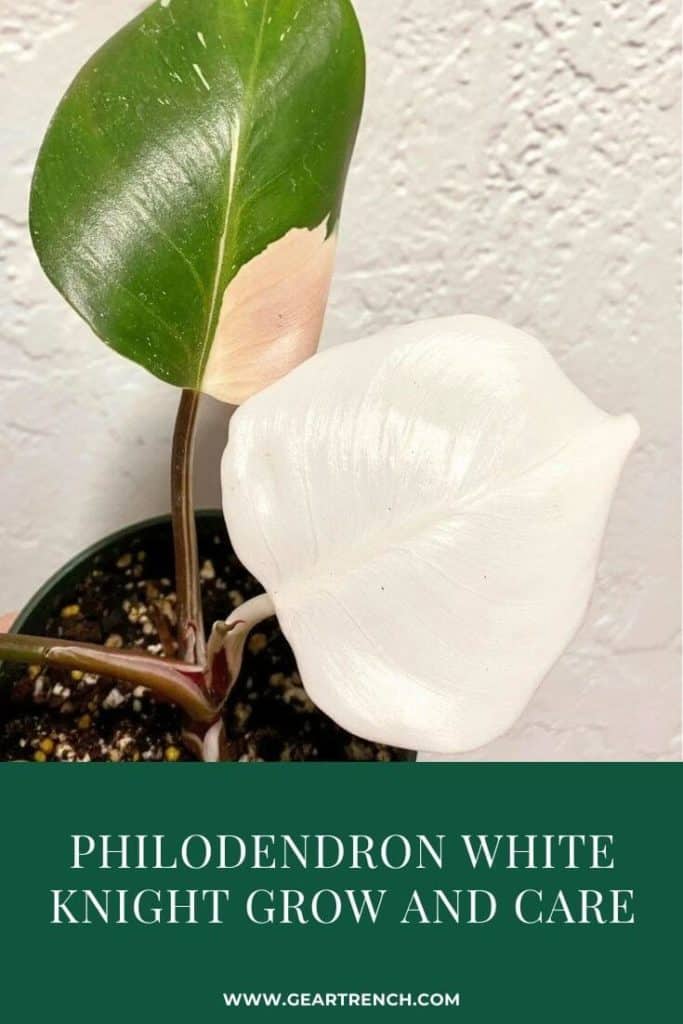
Don’t forget to share this post



